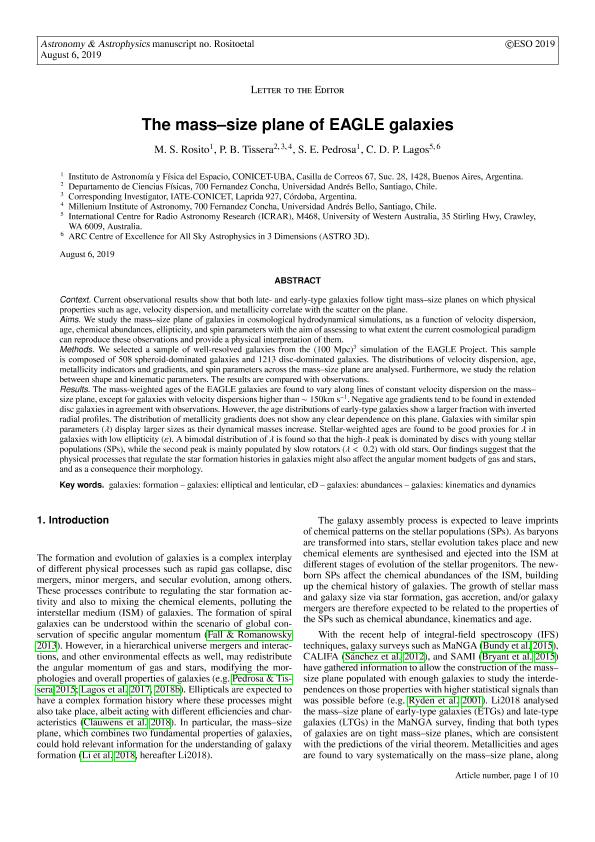Artículo
The mass-size plane of EAGLE galaxies
Fecha de publicación:
08/2019
Editorial:
EDP Sciences
Revista:
Astronomy and Astrophysics
ISSN:
0004-6361
Idioma:
Inglés
Tipo de recurso:
Artículo publicado
Clasificación temática:
Resumen
Context. Current observational results show that both late- and early-type galaxies follow tight mass–size planes on which physical properties such as age, velocity dispersion, and metallicity correlate with the scatter on the plane. Aims. We study the mass–size plane of galaxies in cosmological hydrodynamical simulations, as a function of velocity dispersion, age, chemical abundances, ellipticity, and spin parameters with the aim of assessing to what extent the current cosmological paradigm can reproduce these observations and provide a physical interpretation of them. Methods. We selected a sample of well-resolved galaxies from the (100 Mpc)3 simulation of the EAGLE Project. This sample is composed of 508 spheroid-dominated galaxies and 1213 disc-dominated galaxies. The distributions of velocity dispersion, age, metallicity indicators and gradients, and spin parameters across the mass–size plane are analysed. Furthermore, we study the relation between shape and kinematic parameters. The results are compared with observations. Results. The mass-weighted ages of the EAGLE galaxies are found to vary along lines of constant velocity dispersion on the mass– size plane, except for galaxies with velocity dispersions higher than ∼ 150km s−1 . Negative age gradients tend to be found in extended disc galaxies in agreement with observations. However, the age distributions of early-type galaxies show a larger fraction with inverted radial profiles. The distribution of metallicity gradients does not show any clear dependence on this plane. Galaxies with similar spin parameters (λ) display larger sizes as their dynamical masses increase. Stellar-weighted ages are found to be good proxies for λ in galaxies with low ellipticity (ε). A bimodal distribution of λ is found so that the high-λ peak is dominated by discs with young stellar populations (SPs), while the second peak is mainly populated by slow rotators (λ < 0.2) with old stars. Our findings suggest that the physical processes that regulate the star formation histories in galaxies might also affect the angular moment budgets of gas and stars, and as a consequence their morphology.
Archivos asociados
Licencia
Identificadores
Colecciones
Articulos(IAFE)
Articulos de INST.DE ASTRONOMIA Y FISICA DEL ESPACIO(I)
Articulos de INST.DE ASTRONOMIA Y FISICA DEL ESPACIO(I)
Articulos(IMAS)
Articulos de INSTITUTO DE INVESTIGACIONES MATEMATICAS "LUIS A. SANTALO"
Articulos de INSTITUTO DE INVESTIGACIONES MATEMATICAS "LUIS A. SANTALO"
Citación
Rosito, María Sol; Tissera, P. B.; Pedrosa, Susana Elizabeth; Lagos, C. D. P.; The mass-size plane of EAGLE galaxies; EDP Sciences; Astronomy and Astrophysics; 8-2019; 1-10
Compartir
Items relacionados
Mostrando titulos relacionados por título, autor y tema.
-
Artículo New quantitative nitrogen abundance estimations in a sample of Seyfert 2 active galactic nucleiDors Jr., O. L.; Arellano Córdova, K. Z.; Cardaci, Monica Viviana ; Hägele, Guillermo Federico (Wiley Blackwell Publishing, Inc, 2017-06)
-
Dors, Oli L.; Agarwal, B.; Hägele, Guillermo Federico ; Cardaci, Monica Viviana ; Rydberg, Claes Erik; Riffel, R. A.; Oliveira, A. S.; Krabbe, A. C. (Wiley Blackwell Publishing, Inc, 2018-09)
-
Carvalho, S.P.; Dors, O. L.; Cardaci, Monica Viviana ; Hägele, Guillermo Federico ; Krabbe, Nora Cristina; Pérez Montero, E.; Monteiro, A.F.; Armah, M.; Freitas Lemes, P. (Wiley Blackwell Publishing, Inc, 2020-06)




